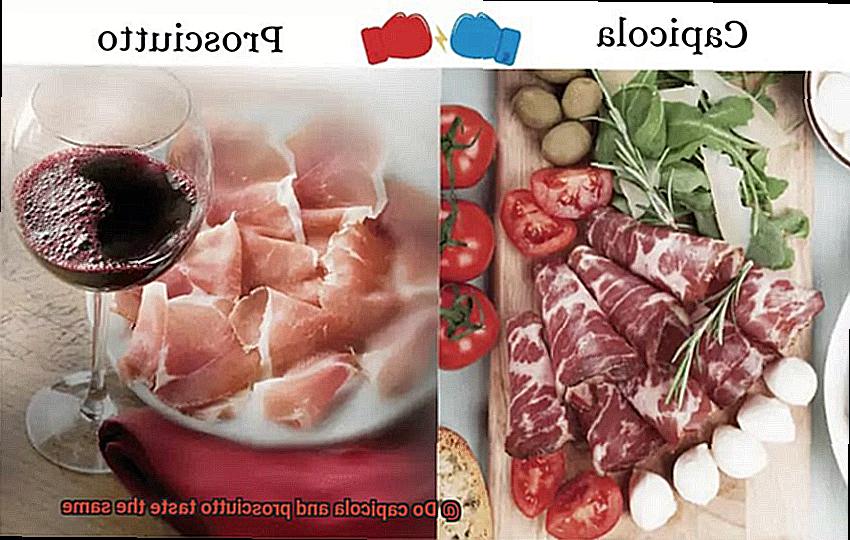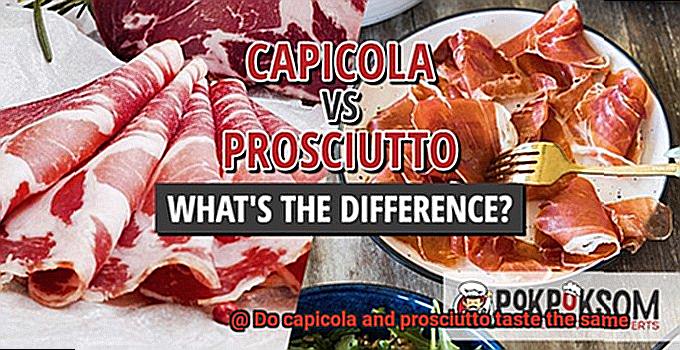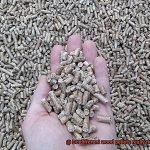If you’re a food lover, you know that there’s nothing quite like the delicate, savory taste of cured meats. And when it comes to this culinary delight, two of the most popular types are capicola and prosciutto. Whether you prefer them in a salad, on a charcuterie board, or in a sandwich, these meats offer a unique flavor and texture that can take any dish to the next level.
But let’s get down to business: do capicola and prosciutto actually taste the same? At first glance, these two meats may look similar due to their appearance. But don’t be fooled – capicola and prosciutto come from different parts of the pig and are cured using different methods and spices. So if you’re wondering which one is right for you, keep reading.
In this blog post, we’ll explore all the differences between capicola and prosciutto. From their flavor profiles to their histories, we’ll compare and contrast these two delicious cured meats so that you can make an informed decision based on your taste buds.
So, whether you’re a seasoned foodie or just looking to expand your culinary horizons, get ready for a mouth-watering journey into the world of cured meats. We’ll show you everything you need to know about capicola and prosciutto – and help you discover which one truly satisfies your cravings.
Contents
What is Capicola?
Capicola, a beloved Italian cured meat, is also known as coppa or capocollo. This delicious cold cut is made from the neck and shoulder of the pig, which is dry-cured with a blend of salt, sugar, and spices like pepper, paprika, fennel seeds, and garlic. The result is a rich and savory flavor that’s slightly spicy and salty, making it one of the most versatile meats in Italian cuisine.
One of the standout features of capicola is its texture. The meat is tender and slightly fatty with marbling throughout, giving it a unique mouthfeel. When sliced thin, it can be easily enjoyed on its own or added to a charcuterie board or antipasto platter. Its bold flavor profile also sets it apart from other cured meats like prosciutto.
Speaking of which, capicola is often confused with prosciutto due to their similar appearance. But there are distinct differences between the two. Prosciutto is made from the hind leg of the pig and has a delicate, buttery flavor with a melt-in-your-mouth texture. In contrast, capicola has a firmer texture with more fat content and a bolder flavor that stands out in any dish.
Capicola’s versatility means it can be used in many different ways. It makes an excellent addition to sandwiches, pizzas, and salads. It also pairs well with grilled vegetables or baked potatoes. And let’s not forget about wine or beer. Capicola’s smoky flavor pairs perfectly with red wine or beer.
What is Prosciutto?
Prosciutto is made from the hind leg of a pig, which is salted and then dried for several months. This process results in a concentrated flavor and tender texture that’s perfect for slicing thinly and serving as an appetizer or as a part of a charcuterie board.
One type of prosciutto that stands out above the rest is prosciutto di Parma. This highly prized delicacy is made in Italy’s Parma region using traditional methods that have been passed down for generations. The quality of this prosciutto is so exceptional that it has been awarded a designation of origin status, meaning only prosciutto made in this region using specific methods can be called “prosciutto di Parma.”
Prosciutto’s versatility in cuisine is one of its many advantages. In Italian dishes, it’s a staple ingredient used to create delicious pasta carbonara, mouthwatering melon and prosciutto salad, and even pizza toppings. When paired with cheeses like mozzarella or Parmesan, the combination creates an explosion of flavors that will leave your taste buds craving more.
What sets prosciutto apart from other types of cured meats like capicola is its unique flavor profile. While both meats are made from pork, capicola tends to have a more intense, spicy flavor due to the addition of spices like paprika or chili flakes during the curing process. Prosciutto has a delicate, sweet flavor with a slightly salty finish that makes it an ideal partner for other ingredients.
How are Capicola and Prosciutto Different?
While they may look similar, there are some key differences between these two delectable meats that make them perfect for different dishes and occasions.
Capicola, also known as coppa or capocollo, is made from the neck or shoulder of the pig and seasoned with garlic, fennel, and red pepper flakes. After it’s aged for several months, it develops a slightly spicy and tangy flavor with a tender yet chewy texture. Capicola is ideal for pizzas, sandwiches, or pasta dishes that need a little kick.
Prosciutto, on the other hand, is made from the hind leg of the pig and dry-cured with salt for several months. This process results in a delicate, salty flavor with a buttery texture that melts in your mouth. Prosciutto is often served raw as an appetizer or in sandwiches. Its subtle flavor and smooth texture make it perfect for antipasti platters or as a topping on crostini.
The differences between these two meats come down to their cuts of meat and curing processes. While both are delicious in their own right, their unique flavors make them ideal for different dishes. Here’s a quick summary of capicola vs prosciutto:
- Cut of meat: Capicola is made from the neck or shoulder of the pig, while prosciutto comes from the hind leg.
- Seasonings: Capicola is seasoned with garlic, fennel, and red pepper flakes, while prosciutto is simply cured with salt.
- Flavor: Capicola has a slightly spicy and tangy flavor, while prosciutto has a delicate, salty flavor.
- Texture: Capicola has a tender yet chewy texture, while prosciutto has a smooth, buttery texture.
Taste Comparison of Capicola and Prosciutto
Both of these cured meats are incredibly popular in Italian cuisine and have their unique flavor profiles, which make them ideal for different dishes.
Let’s start with capicola, also known as coppa. This dry-cured meat is made from the muscle along the pig’s neck and seasoned with garlic, fennel, and red pepper flakes. The result is a hearty, rich flavor with a slight kick of spice. With its firm texture, capicola can be sliced thinly and used in sandwiches or antipasti platters. Its bold flavor profile makes it perfect for adding a spicy kick to pizza or pasta dishes.
Prosciutto, on the other hand, is made from the hind leg of the pig and is cured with salt before being aged for several months. This results in a delicate flavor that is slightly sweet and salty. Prosciutto has a buttery texture that melts in your mouth, making it perfect for enjoying on its own or paired with cheese and crackers. Its subtle flavor profile makes it ideal for antipasti platters or crostini toppings.
But why limit yourself to just one? Both capicola and prosciutto are delicious and can be incorporated into a variety of dishes. Here are some ideas:
- Use capicola as a spicy addition to your favorite pizza or pasta dish.
- Wrap thin slices of prosciutto around melon slices for a refreshing appetizer.
- Make a charcuterie board with both capicola and prosciutto, along with cheeses, olives, and bread.
- Add capicola to your breakfast sandwich for an extra protein boost.
- Make a panini with prosciutto, mozzarella cheese, and pesto spread.
Texture Comparison of Capicola and Prosciutto
I am here to guide you through the nuances of these two delectable meats.
Firstly, let’s delve into capicola, also known as coppa. This dry-cured meat originates from the neck and upper shoulder muscle of the pig, making it a leaner option that sports a chewier texture. Upon slicing, you’ll immediately notice its dense texture and visible muscle fibers. Capicola comes in varying thicknesses, with thinner slices yielding a slightly softer texture than thicker ones.
In contrast, prosciutto is crafted from the hind leg of the pig and boasts a higher fat content. This dry-cured meat has a soft texture that melts in your mouth due to its fat content. Unlike capicola, prosciutto has a smooth and delicate texture, giving it an almost buttery feel.
When comparing both meats side by side, the differences in texture are palpable. Capicola’s firm and chewy texture with visible muscle fibers contrast starkly with prosciutto’s soft and smooth melt-in-your-mouth feel.
Popular Varieties of Italian Prosciutto
Italian prosciutto has been a beloved staple of the country’s cuisine for centuries, and with good reason. With its unique flavor and texture profiles, there are several popular varieties of Italian prosciutto that every foodie should try.
First on the list is Prosciutto di Parma, which is made in the Emilia-Romagna region using only the highest quality pork from specially raised pigs. The meat is cured with salt and air-dried for at least 12 months to create a tender, buttery texture and a delicate, slightly sweet flavor.
Next up is Prosciutto di San Daniele, which comes from the Friuli-Venezia Giulia region of Italy. The pigs used for this variety are fed a special diet to enhance their flavor, and the meat is cured with sea salt and air-dried for at least 13 months. The result is a firm, chewy texture and a rich, nutty flavor that will leave you wanting more.
For those who prefer a more complex flavor profile, there’s Prosciutto di Carpegna. Hailing from the Marche region of Italy, this variety uses only the hind legs of specially raised pigs that are fed a diet of acorns and chestnuts. The meat is cured with sea salt and air-dried for at least 14 months to create a firm, slightly crumbly texture and a savory, complex flavor.
While capicola may look similar to prosciutto, it is not the same thing. Made from pork shoulder or neck that has been seasoned with spices and cured with salt, capicola is air-dried for several weeks to create a rich, smoky flavor and a melt-in-your-mouth texture that will leave you hooked.
Uses for Capicola and Prosciutto

These two cured meats are must-haves in any kitchen, and as an expert in the field, I can attest to their versatility and flavor profiles.
First up, we have capicola, also known as coppa or capocollo. This Italian meat is made from the neck or shoulder of the pig and has a rich, slightly spicy flavor that will take your sandwiches, pizzas, and antipasti platters to the next level. But that’s not all – capicola is also perfect for pasta dishes like carbonara or arrabbiata. And if you’re feeling adventurous, try wrapping it around asparagus for a tasty appetizer that will leave your guests wanting more.
Next up, we have prosciutto. This dry-cured ham is delicate and sweet with hints of nuttiness that make it a popular topping for pizzas and a perfect addition to pasta dishes. But my personal favorite way to enjoy prosciutto is as an appetizer with melon or figs. The combination of sweet and savory flavors creates a taste explosion in your mouth that you won’t soon forget.
But here’s the best part – both capicola and prosciutto can be used interchangeably in some dishes. Use them as pizza toppings or add them to sandwiches for an extra flavorful kick. And don’t forget about their potential as stand-alone snacks or charcuterie board staples. Pair slices of both meats with other cured meats, cheeses, fruits, and nuts for a visually appealing spread that will impress any guest.
Tips for Preparing Italian Cured Meats
Italian cured meats like capicola and prosciutto are a delicacy that many people enjoy. These meats have rich, savory flavors that are best enjoyed when prepared properly. Here are some tips for preparing Italian cured meats to ensure that they are served and enjoyed at their best.
Slice Thinly
One of the most important tips for preparing Italian cured meats is to slice them thinly. This not only enhances the texture of the meat but also ensures that the flavors are evenly distributed in each bite. To achieve thin slices, use a sharp knife and aim for slices that are no thicker than a credit card.
Serve at Room Temperature
Another tip is to let the meat come to room temperature before serving. This allows the flavors to fully develop and brings out the natural sweetness of the meat. So, take your capicola or prosciutto out of the refrigerator at least 30 minutes before serving.
Pair with Complementary Flavors
Pairing your cured meats with complementary ingredients can help bring out their flavors even more. For example, prosciutto pairs well with melon or figs while capicola can be served with sharp cheeses like Parmesan or Pecorino. You can also serve them with olives, bread, or crackers.
Store Properly
Proper storage is essential to keep your Italian cured meats fresh and flavorful. Wrap the meat tightly in plastic wrap and store it in the refrigerator for up to two weeks. Alternatively, you can freeze the meat for up to six months.
Use as a Finishing Touch
Finally, when cooking with these cured meats, it’s important not to overcook them as they can become tough and lose their delicate flavors. Instead, use them as a finishing touch or garnish on dishes like pizzas, salads, or pasta dishes.
JYYLyvdS5Nc” >
Conclusion
In summary, capicola and prosciutto may resemble each other in appearance, but their distinct flavors and textures set them apart. Capicola boasts a savory and slightly spicy taste with a chewy yet tender texture, while prosciutto’s buttery flavor melts in your mouth. These cured meats have various culinary uses, from antipasti platters to pizzas and sandwiches.
To savor the best of both worlds, it’s crucial to slice them thinly and serve them at room temperature to bring out their unique flavors. Pairing them with complementary ingredients like cheese or fruits can elevate their taste even further. Proper storage is also key to keeping these cured meats fresh and flavorful.
Whether you’re an Italian cuisine enthusiast or a novice foodie, exploring the world of capicola and prosciutto is a delicious journey worth taking. So why not indulge in both?






